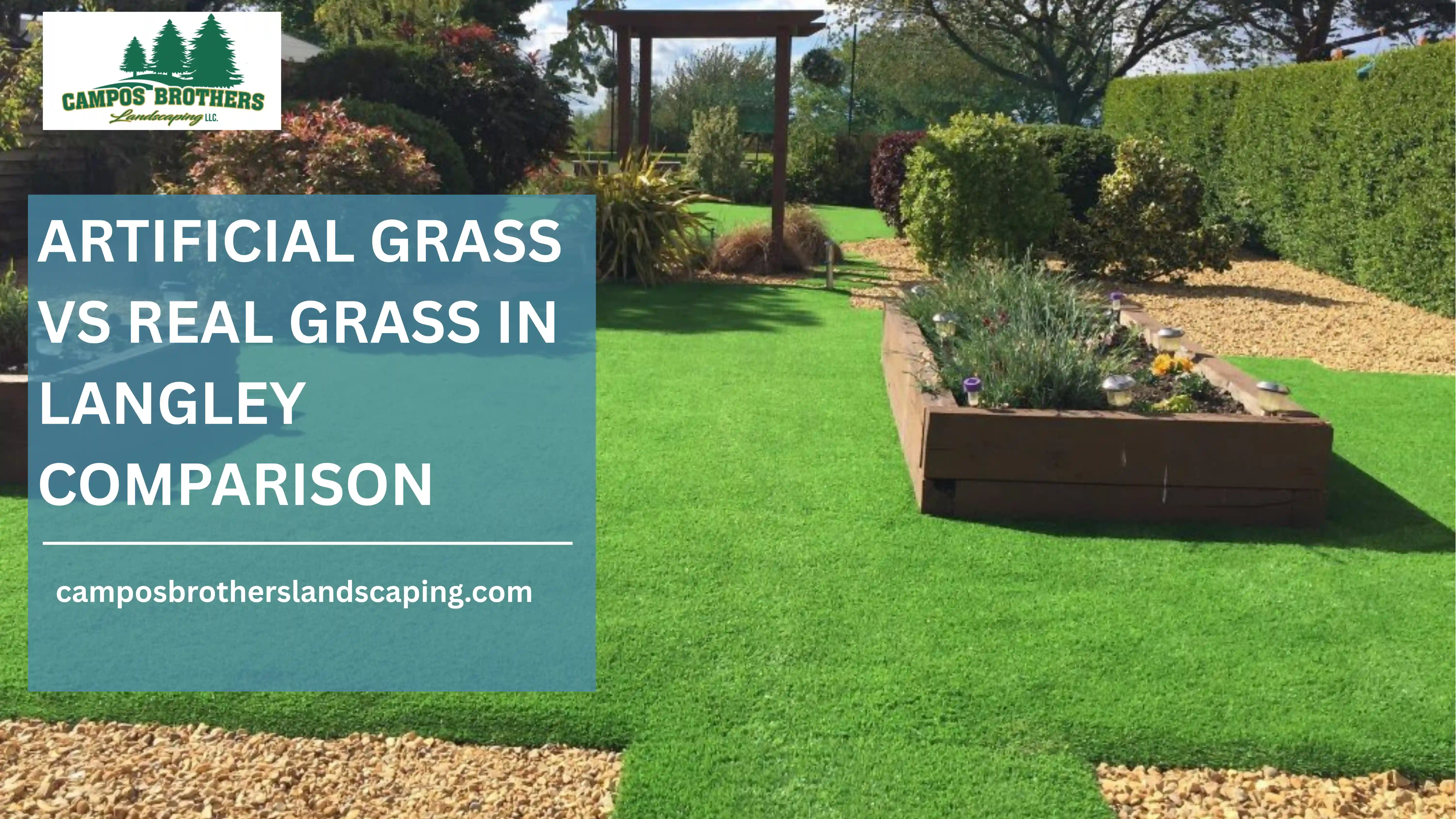Artificial Grass vs Real Grass in Langley Comparison

Choosing a lawn is one of the biggest decisions you can make for your home's exterior. For a long time, the only choice was a living, natural lawn. Today, technical skill has produced a highly realistic alternative, leaving many homeowners asking the same question: Artificial Grass vs. Real Grass? This isn't just about looks. It's a serious calculation of money, time, environmental effects, and long-term performance.
To make a good choice, you have to look past the green surface and understand what it's like to live with each one. It’s a core part of modern landscaping, a conversation that specialized firms, from local businesses like Campos Brothers Landscaping to national installers, are having with clients every day.
Understanding the Materials
Before comparing them side-by-side, it’s helpful to know what each surface truly is.
What is Natural Grass?
A natural lawn is a living, breathing system. It's a community of plants (like Fescue, Bermuda, or St. Augustine) that depend on the soil, air, and water. It actively breathes, absorbing carbon dioxide and releasing oxygen. It supports a whole world of soil life, filters stormwater, and provides a real cooling effect on the air around it. You can feel the temperature drop over a real lawn. Its survival is tied directly to good soil, sunlight, and plenty of water.
What is Artificial Grass?
Artificial grass, or synthetic turf, is an engineered surface. It's manufactured from plastic polymers—usually polyethylene, polypropylene, or nylon—to create "blades" that are stitched into a permeable backing. This turf is then rolled out over a carefully prepared base of compacted gravel and sand. That base is critical for making sure water drains properly, and it's what separates a professional job from a lumpy, problem-filled lawn. Finally, an "infill" material (like silica sand) is spread over the top to help the plastic blades stand up and to give the lawn a cushioned feel.
A Comparative Analysis: Key Decision Factors
So, how do these two stack up in the areas that matter most to a homeowner? When you put artificial grass vs real grass, the real differences in ownership become very clear.
Financials: The Story of Cost
The money part of this choice is a classic story: pay a lot now, or pay a little forever.
- Natural Grass: The initial cost to get started, especially with sod, is fairly low. A typical 500-square-foot sod installation might run $500 - $1,000. The real cost is the non-stop upkeep. Between water bills, fertilizers, weed killers, aeration, and equipment, you can easily spend $500 to $1,500+ every year, forever.
- Artificial Grass: The initial installation is a major investment. That same 500-square-foot lawn could cost between $5,000 and $10,000. It’s a hard number to swallow, but it includes the heavy-duty ground preparation, the gravel base, and the turf itself. The financial payoff is that the annual maintenance cost is almost nothing. Most people find they break even on their investment in about 5 to 7 years.
Maintenance: The Investment of Time
The financial cost is one thing; the human cost is another. This is where your lifestyle really comes into play.
- Natural Grass: This is a serious time commitment. It needs to be mowed every week in the growing season. It also demands a whole calendar of lawn maintenance tips: feeding it in the spring and fall, aerating to keep the soil from turning into a brick, and a constant battle against weeds and pests.
- Artificial Grass: This is a low-effort surface. It completely removes mowing, watering, and fertilizing from your to-do list. But it's important to know that "low-maintenance" is not "no-maintenance." It's often sold as a "set it and forget it" product, but that's not the whole truth. It still needs a leaf blower to clear off debris. If you have pets, it needs to be hosed down regularly to clear waste and prevent odors. In high-traffic spots, you'll need to brush it with a stiff broom to fluff the blades back up. It is drastically less work, but it is not zero work.
Durability and Lifespan
With such a high cost, people rightly ask, "How long does artificial grass last?" A high-quality synthetic turf usually comes with an 8 to 15-year warranty and can realistically be in service for 15 to 25 years. How long it lasts depends on sun intensity, how much use it gets, and the quality of the plastic. A real lawn, on the other hand, can last forever, but it's fragile. It gets bald spots from pets, browns out in a drought, or gets overrun by crabgrass, forcing you to start over or do a major reseeding project.
Quick-Look Comparison Table
Here is a simple breakdown of the key differences:
| Feature | Natural Grass | Artificial Grass |
|---|---|---|
| Average Initial Cost | $1 - $2 per sq. ft. (Sod) | $10 - $20 per sq. ft. (Installed) |
| Annual Maintenance Cost | High ($1,000+ avg.) | Very Low (Occasional cleaning) |
| Water Usage | High (Requires regular irrigation) | None (Only for hosing off) |
| Surface Temperature | Cool (Natural cooling effect) | Hot (Can be 40-60°F hotter than air) |
| Environmental Impact | Produces O2, filters water, supports life. Needs high water/chemicals. | Conserves water, no chemicals. Is a non-biodegradable plastic. |
Advantages and Disadvantages: The Full Picture
That table gives a good summary, but the numbers don't tell the whole story. The lived-in experience of either lawn comes down to its specific strengths and weaknesses. Weighing the pros and cons of artificial grass against a living lawn is where most people find their answer.
The Case for Artificial Grass
The appeal of synthetic turf is based on solving common homeowner frustrations. Its primary appeal is its consistency. You get a "perfect" green lawn 365 days a year, regardless of weather. This is a huge benefit for backyard landscaping ideas where a clean, modern look is desired. In drought-prone states, the water conservation aspect is a powerful motivator, potentially saving thousands of gallons of water annually. For busy families or those who travel, the "low-maintenance" promise is real. It gives you your weekends back, removing the weekly chore of mowing and the seasonal calendar of fertilizing and weeding. And its durability is a major plus for pet owners who are tired of muddy paws and yellow spots, or for parents who want a play area that doesn't turn into a mud pit after one rainstorm.
The Drawbacks of Artificial Grass
The most obvious drawback is the significant upfront cost. It is a major home improvement expense, and that initial bill is the biggest barrier for most people. The second major issue is heat. The plastic and rubber components absorb and hold solar radiation, with surface temperatures on a hot day soaring 40 to 60 degrees (F) hotter than the air. This can make the lawn unusable for children and pets during peak summer afternoons. Finally, there is the environmental footprint. It is a petroleum-based product. Energy is used to manufacture and transport it, and at the end of its 15-25 year life, it is extremely difficult to recycle, meaning it almost always ends up in a landfill as bulky plastic waste.
The Case for Natural Grass
The argument for real grass is often emotional and ecological. It is a living thing. You get the smell of fresh-cut grass, the cool, soft feel under bare feet, and the knowledge that you are hosting a living ecosystem. A healthy lawn actively produces oxygen, filters pollutants from the air, and helps cool the entire microclimate of your property. It does a fantastic job of absorbing and filtering stormwater, reducing runoff into storm drains. For those who enjoy gardening, the work of maintaining a lawn can be a relaxing, rewarding process, not a chore.
The Drawbacks of Natural Grass
The reality of that living system is that it's needy. Its biggest demand is water. In many parts of the U.S., a lawn cannot survive on rainfall alone and requires constant, heavy irrigation, which is both expensive and ecologically questionable in many areas. It also requires a serious commitment of time. The cycle of mowing, fertilizing, and weeding is never-ending. And even with perfect care, it's vulnerable. It can be damaged by pests, taken over by weeds, or killed off by a sudden heatwave or fungal disease, forcing you to spend more time and money on repairs.
Making a Choice for Your Home
So, after all that, which is better? The best choice is personal and depends heavily on where you live.
- A natural lawn is probably the right fit if you live in a place with good rainfall, if you genuinely like being in the yard, and if you want a living, cooling part of your home.
- An artificial lawn is a very strong option if you live in a drought-prone area, have a small or heavily shaded yard, or if your main goal is a durable, no-fuss surface for pets and play.
Conclusion
The artificial grass vs real grass debate is really a question of your personal priorities. One path gives you a living landscape that asks for your continuous time and resources. The other gives you a static, low-effort surface that asks for a large upfront payment and has a different environmental cost.
By honestly looking at the numbers on cost, water, and labor, every homeowner can pick the solution that truly fits their property and their life. That kind of long-term thinking is what defines a successful landscape, a principle that quality-focused businesses like Campos Brothers Landscaping have built their reputations on.
